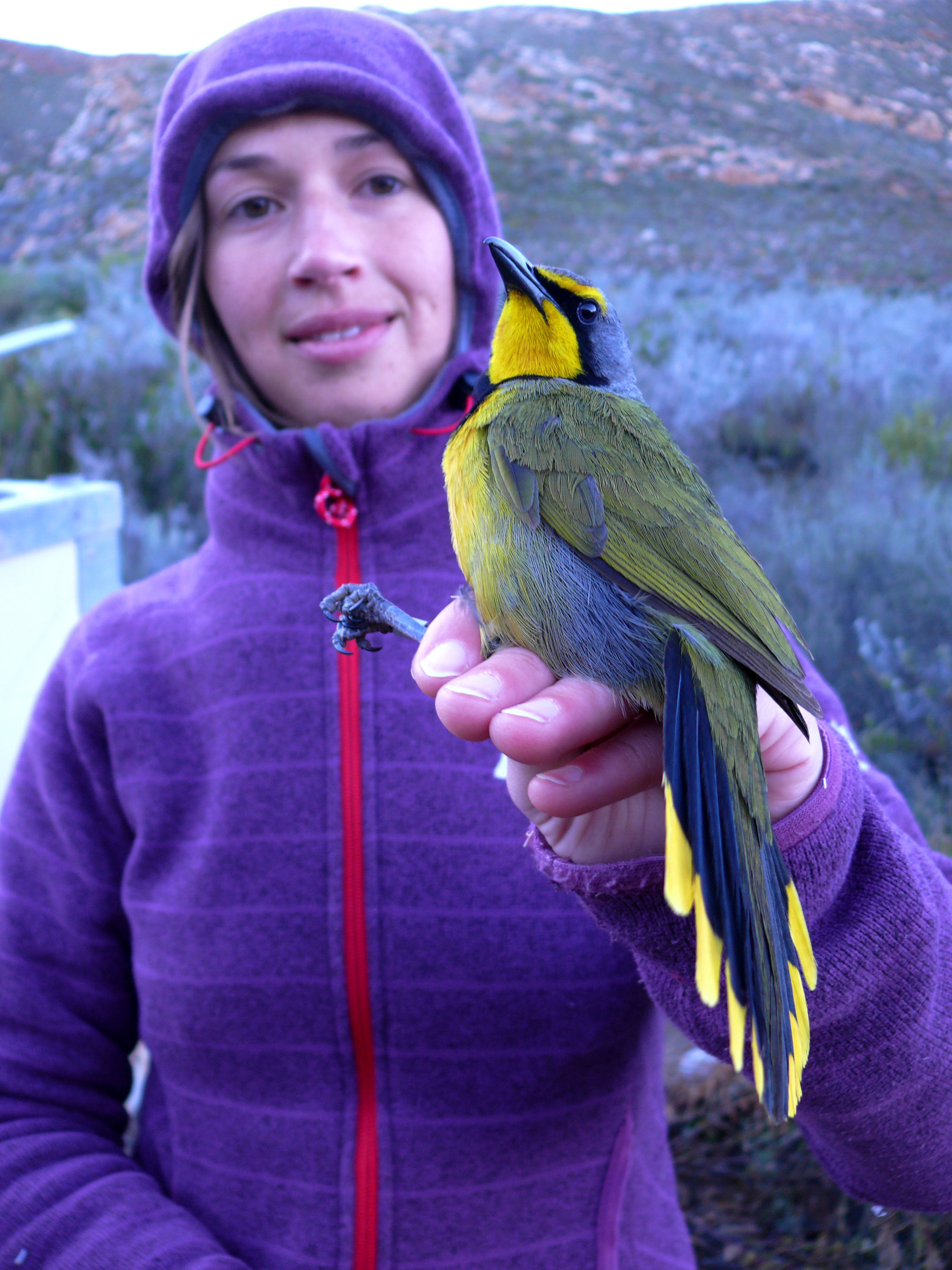Hot birds in trouble
09 June 2017 | Story Helen Swingler.
Like mammals, birds have a ‘happy place’ in terms of body temperature. But as the climate heats up, some species are working harder to stay cool, which is compromising their ability to forage or feed chicks. This thermal trade-off has massive implications for their survival − and for our ecosystems. But, according to a new paper published in the Journal of Experimental Biology, dominant birds in communal nests may just have things a little easier.
The rufous-cheeked nightjar builds her nest on open ground in the Kalahari, sitting on her eggs in the blazing sun, where ground temperatures sometimes reach 65°C.
Further west, in the Kuruman River Reserve, hot weather − anything above 35°C − will see the pied babbler foraging less efficiently, with consequences for her and her nest.
The rufous-cheeked nightjar has a highly efficient air-cooling system: she vibrates her throat membrane very fast (gular fluttering) throughout the day. The pied babbler is less efficient; to stay cool she must open her beak and pant to draw air in, resulting in tiny gasping movements that deplete her metabolic reserves. She will struggle to maintain her body weight over 24 hours if it’s hotter than 36°C.
Researchers believe that the efficiency of birds’ thermoregulation mechanisms will affect their ability to cope with rising temperatures in the face of climate change. The question is: Which birds are most likely to be affected and how will this impact on ecosystems?
Climate change is the biggest threat to global biodiversity. Because many desert species already live near the limits of their physiological tolerances, these communities can act as early warning indicators of the effects of climate change, says lecturer Dr Susie Cunningham of UCT’s Percy FitzPatrick Institute of African Ornithology (the Fitztitute).
Cunningham is principal investigator of the Hot Birds Project, a collaboration with Professor Andrew McKechnie of the University of Pretoria. They spearhead a three-continent collaboration of behavioural ecologists and ecophysiologists to understand the likely effects of climate change on desert bird communities.
Life with birds
The Hot Birds Project title was tongue-in-cheek, reminiscent of the late Professor Phil Hockey’s sense of pun − and fun. Hockey started the project in 2009.
“By the time I got here, the name had stuck,” says Cunningham wryly.
That was in 2010 when the PhD student from Massey University in Manawatu, New Zealand, arrived as a postdoctoral research fellow. Her doctoral thesis had explored the foraging behaviour of kiwis and later ibises and shorebirds.
Looking for a postdoc, she stumbled on a Fitztitute advert. It was a year old but Hockey liked her track record and offered her a spot.
Her first season here was in the Kalahari, studying fiscal shrikes’ behaviour trade-offs in high temperatures. The birds were getting into trouble in the mid-30s, declining from being good hunters (they pounce on prey spotted from exposed perches) to sub-optimal hunters, the heat driving them to shady perches from where it’s harder to hunt. There was a knock-on effect for their chicks’ growth and nest success, with implications for their long-term survival.
The heat came as a bit of a shock for Cunningham too.
“I’d been working in temperate rainforests with nocturnal birds and my main thermoregulatory problem was keeping warm enough!”

Hot birds in trouble
Research by postgraduate students at the Fitztitute has added to the picture, showing that many bird species − including yellow-billed hornbills and fork-tailed drongos − get into trouble in the mid-30s.
“So that 35°C threshold comes up again and again,” says Cunningham. “The birds that can keep cool efficiently are the ones that are good at evaporating lots of heat without expending too much energy to do so.
“If you’re in this environment, where energy and water are hard to come by, it makes sense for birds to avoid paying these high physiological costs, and they will change their behaviour, for example by seeking shady locations, in order to do so.”
But behavioural changes incur other costs.
“With the fiscal shrike, moving from the sun to a shady perch reduced their foraging efficiency by 50%. So, they have to make this trade-off – perhaps not consciously − and decide whether they’re going to pay a physiological or behavioural cost to keep their body temperature stable.”
World record for coolness
Which birds are the most adept at coping with heat?
McKechnie’s recent research on the Namaqua dove, common in hot regions of Namaqualand, the Karoo and Kalahari, set a world record in 2016. This little bird knows how to be cool; it evaporates about 450% of its metabolic heat production through cutaneous evaporation (birds don’t have sweat glands).
That record was short-lived. McKechnie’s PhD student Ryan O’Connor’s research showed that rufous-cheeked nightjars were evaporating over 500% – that’s over five times their metabolic heat production – thanks to their spectacular gular fluttering ability.
The group is trying to understand this dynamic across species on three continents: here, in Australia and in North America.
Why don’t the birds under threat migrate to cooler climates? It’s not that simple, notes Cunningham.
“Some birds can move and some are moving; pied crows are a good example of a bird that’s moving in response to climate change. But this has huge ramifications for habitat requirements. If you’re a generalist species, you can shift from one habitat to another. If your habitat isn’t shifting, you still might have to – and you might survive that. But if you’re a specialist that’s tied to the forest or savanna, it’s not enough to have a pair of wings; your habitat needs to be mobile too. So, one of our major concerns is species being decoupled from their habitats, both in time and space.”
Globally, Cunningham says it appears that many species – animals, birds and plants – appear to be shifting in response to climate change.
“So poleward and uphill seems to be the general pattern. They follow favoured climatic envelopes, which are shifting, so they’re tracking their own favourite temperature range. But it’s a complicated world out there and some animals, plants and birds are better equipped than others to be able to do so.”
Social status in communal birds
This point is borne out by another facet of the Hot Birds Project research, illustrated by a paper in the most recent edition of the Journal of Experimental Biology, co-authored by Cunningham, McKechnie and Michelle Thompson.
They found that within Kalahari communal bird groups, such as sociable weavers, who you are makes a difference to how good you are at keeping your body temperature stable.
“Social status alters your short-term risk of heat stress. In really hot conditions, dominant birds within these groups were able to maintain lower and more stable body temperatures more efficiently than their subordinates.
“We think this is important because it suggests that within social groups, not everyone will be equally affected by climate change. But this has implications for the stability of social groups because subordinates play important roles.
“Even if dominant birds survive, they’re in trouble if they lose the help of subordinates. Societies as a whole are negatively affected by inequality. So, there’s a good social message for you!”
The project has postdoctoral research fellow Dr Margaux Rat working on social networks within sociable weaver communities to understand what happens to that society when it’s under increasing thermal stress because of global warming.
The research has tantalising implications for other social species, adds Cunningham.
“And that’s something we want to investigate as it has potential implications for humans.”
The stakes are high.
“Climate change is happening across the globe, not just in the places we’ve disrupted but in pristine or protected areas as well, and it’s pervasive. This makes things very difficult. You can’t put a great big umbrella over the Kalahari. We’ve tried shading waterholes, but even that’s complicated. Some birds respond positively; others don’t. There’s no straightforward solution except to divest from fossil fuels,” she says.
“Please.”
 This work is licensed under a Creative Commons Attribution-NoDerivatives 4.0 International License.
This work is licensed under a Creative Commons Attribution-NoDerivatives 4.0 International License.
Please view the republishing articles page for more information.










